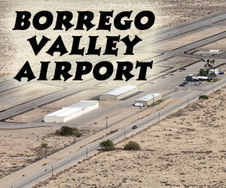Visitor's View – Culp Valley
Last updated 7/18/2023 at 12:24pm
On the map, it's marked as Culp Valley, but since my first trip when a glorious arch of colors was hanging over this wilderness pot of gold, I've called it The Valley of Rainbows.
Like a geological balcony overlooking Borrego Valley, most visitors pass through this bouldery basin along Montezuma Grade as they drop down from Ranchita.
For most travelers, it's just a place they pass along the way. Not much to see, so let's keep moving.
But this small little bowl sits at an elevation of around 3,200 and that means it will frequently be a bit cooler than the desert floor on searing summer days.
Culp Valley's unique location is also what makes it a haven for rainbows.
When winter storms blow in from the west, clouds and rain generally break off at the crest of the mountains.
But strong winds push the rain out over Culp Valley where desert sunshine hits the raindrops, creating the spectacular show of rainbows. On a stormy day, it's a sure bet to find a rainbow here.
Additionally, the area's unique geology, a cozy campground, hiking trails, historic cultural sites and plenty of varied wildlife make this a destination worth a few hours or a few days of exploration.
Culp Valley first comes into view as the terrain of the San Ysidro Mountains breaks off and you begin to descend on Highway S-22 east of Ranchita. Passing the turn off into the Culp Valley Campground on your left, the road makes a sweeping curve into the flatter portions of the valley.
Here, on an early morning drive, you may see mule deer feeding on native vegetation, or a bit further, a herd of desert bighorn sheep catching the morning sun on huge boulders in the distance.
The campground in Culp Valley is one of those little secrets we won't tell anyone about. Tucked between rock piles, campers can enjoy their privacy and the tranquility of the desert highlands.
The free campground does have vault toilets, but no water, picnic tables or fire rings and for the tent or small trailer camper is a hidden gem.
Summer campers in Culp Valley will enjoy cooler evenings and the night sky away from city lights will be nothing less than breathtaking.
One of the most spectacular views in the area is from a scenic overlook about a half mile from the campground along the easy Culp Valley Trail that joins the California Riding and Hiking Trail.
For the more adventurous hiker, you can continue from the overlook, completing a 2.2-mile hike on the Culp Valley Loop Trail that includes a half-mile spur to Pena Spring.
There is water here, but it's mostly a seep that attracts wildlife and birds. This can be an exciting place to sit awhile if you are a birder.
This is rugged terrain, but relatively open, so if cross country hiking is your thing, there is plenty here to enjoy.
Culp Valley receives more rain that the more arid areas to the east. This means there is often a more spectacular wildflower display that appears a bit later in the springs because of the higher elevation.
Off-roaders with street legal vehicles have several routes in the area they can enjoy for a day of exploration.
The Old Culp Valley Road turns off at the far end of the valley and climbs through boulders as it winds west towards Ranchita. It also joins the Jasper Trail that runs south, eventually dropping into Grapevine Canyon and coming out at Yaqui Pass on Highway 78. This is an enjoyable loop route that can take you into Borrego Springs for lunch or dinner before you climb back up Montezuma Grade to the campground.
At the east end of Culp Valley, visitors will notice a large sign marking the area as a Cultural Preserve, recognizing both the Native American and early settlers who occupied the region.
As late as 1925 there were still some structures standing at the site of a Native village that was documented in 1854 to include nearly a dozen houses and a chapel.
Nearby is the site of the Paroli homestead, a pioneer cattle family that settled in the area in the 1920's. Many of the roads in the area were created by the movement of cattle from mountain pastures in the summer to the desert in winter.
Preserving this area allows current-day visitors a chance to look out over and experience a landscape that has not changed since Native Americans and early pioneers called this place home.
While it might be cooler in Culp Valley in mid-summer, daytime temperatures can still reach into the 100's.
Visitors here should be prepared for the heat. Do not travel alone. It's always a good idea to travel with two vehicles and be well equipped with water and food.
You can reach the author at Ernie at Packtrain.com.







